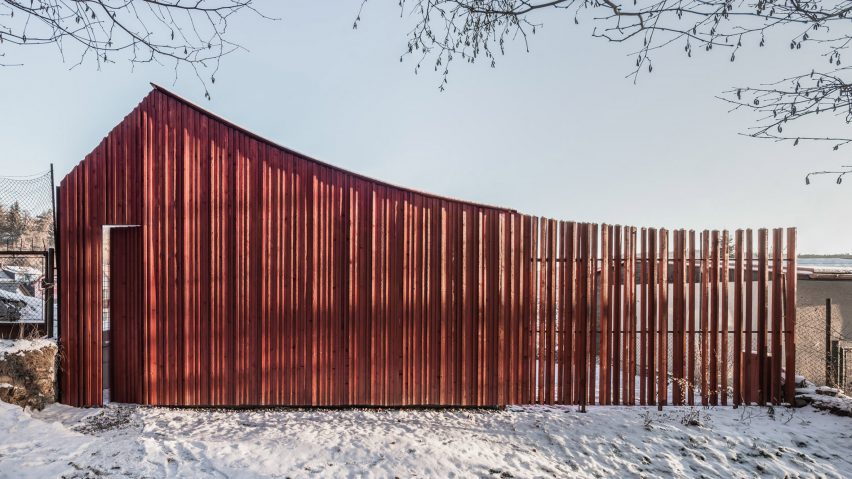A curved roof tops Byró Architekti's Cabin Above the Town, a red timber-clad cabin informed by the surrounding Czech hills.
Situated on the border between the city and the countryside, the cabin is nestled into the side of Svatobor Hill, a forested site in the foothills of the Czech Republic's Šumava mountains.
Taking inspiration from the local landscape, Prague studio Byró Architekti designed the home to have a sweeping form following the curves of the surrounding landscape.
"Thanks to the curved roof, when viewed from the garden or from a distance, the curve of the house follows the horizon of the landscape and symbolically closes the row of surrounding cottages," studio co-founder Jan Holub told Dezeen.
Red-painted timber battens line the walls of the home, extending beyond either side of the path-facing facade to form fences that offer extra privacy.
Beyond one side of the home, a gate hidden within the fence leads to the main entrance, while a courtyard is concealed by the fence on the other side of the building.
"The principle of the house-fence is reinforced by the consistent use of red colour, inspired by the foundation red colour that appears on most fences and cottages in the area," Holub explained.
The battens of the fence become more spaced out as they get further away from the cabin, offering views of the surrounding nature while maintaining a level of privacy.
"The battens gradually become sparser, leaving a visual connection between the courtyard and the surrounding trees, while also providing privacy from passers-by, as they form a non-transparent wall at an angle," said Holub.
Designed for one resident, the home features an open-plan kitchen, living, and sleeping space along with a guest bedroom that is suspended over the main level of the home.
The studio aimed to keep the interior as open as possible, with the bathroom being the only space closed off to the rest of the home. The walls of the bathroom provide additional privacy for the sleeping space, which sits behind it in the corner of the home.
A sloping ceiling covered in plywood panels adds warmth to the interior, reaching its highest point above the mezzanine-level guest bedroom accessed by a ladder.
Throughout the interior, Byró Architekti made use of low-cost furnishings including laminate storage units, bespoke furniture, and cupboards with handmade plywood doors, to keep construction costs to a minimum.
"The house was built essentially from the cheapest materials available," said Holub. "The interior is mainly furnished with custom-made furniture, which helps to efficiently arrange the modest space and provides ample storage space."
"The facade of the house is made up of randomly laid and oriented unplaned roof battens, the floor is made up of simple concrete, and the windows are plastic," Holub continued.
Built within a period of three months, the home was constructed almost entirely by the studio itself.
"This small house offered us a unique experience," said the studio. "In addition to the complete project design we – the architects - also participated in its construction, which we carried out almost entirely on our own between two people."
"The project thus became an experiment for us in every way, and we think the project proves that it is possible to achieve something unique despite a lack of money."
Other Czech houses recently featured on Dezeen include a modern extension of a 1920s villa in Prague and a curved timber-framed home in a Czech forest.
The photography is by Ondřej Bouška.

